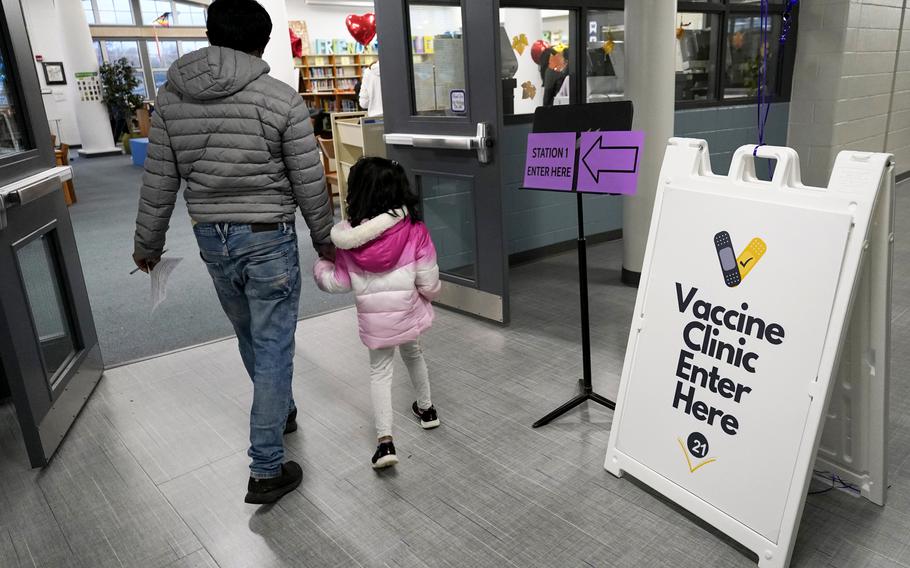
An information sign is displayed as a child arrives with her parent to receive the Pfizer COVID-19 vaccine for children 5 to 11-years-old at London Middle School in Wheeling, Ill., Wednesday, Nov. 17, 2021. (AP Photo/Nam Y. Huh) (Nam Y. Huh)
(Tribune News Service) — Although early data hints the now-dominant omicron variant is associated with more mild illness compared to other versions of the coronavirus, we still don’t have solid answers, especially regarding how the mutant affects different age groups.
But emerging evidence shows children are getting infected with the coronavirus and being hospitalized at alarming rates relative to pre-omicron days, particularly those who are unvaccinated. As a result, kids younger than 5 years old, who are not yet eligible for vaccination, are making up large portions of pediatric COVID-19 surges across the globe.
Still, many experts advise heightened caution rather than panic.
Nationwide, more than 900 children with COVID-19 have been admitted to a hospital as of the week of Dec. 20, up from 800 the week prior, according to the Children’s Hospital of Philadelphia. That’s about 1.1 hospitalizations per 100,000 children, which is still lower than the rate of admission during a typical flu season (about 3 to 5 hospitalizations per 100,000 kids).
“While it’s still early, we’ve not yet seen any data from the omicron variant to make us worry that the risk of severe illness among children has changed,” Dr. Jennifer Nuzzo, an infectious disease expert at the Johns Hopkins Bloomberg School of Public Health, told The New York Times.
“These relatively low risks and our ability to lower them further may help ease some anxieties over the next few months.”
As scientists learn more, experts suggest adults get vaccinated, especially those around kids too young to get shots, avoid crowded indoor spaces, wear masks around young children and try to take rapid COVID-19 tests before gathering with others.
On Christmas Eve, the New York State Department of Health issued a “health advisory” to health care workers warning of surging pediatric hospitalizations tied to COVID-19 in New York City and surrounding areas where omicron is prevalent.
Health officials said there was a four-fold increase in COVID-19 hospitalizations among people 18 and younger from the week of Dec. 5 until Christmastime. A news release said none of the 5- to 11-year-olds in the hospital with the disease were fully vaccinated, and only a quarter of those between 12 and 17 had all their shots.
“The risks of COVID-19 for children are real,” Acting State Health Commissioner Dr. Mary Bassett said in the release. “Protect your children who are five years and older by getting them fully vaccinated and protect children under five by making sure all of those around them have protection through vaccination, boosters, mask-wearing, avoiding crowds and testing.”
In Philadelphia, a study of more than 7,500 K-12 students who tested positive for COVID-19 found a nearly five-fold increase in positive tests beginning about Dec. 13. Most of those who tested positive were unvaccinated.
“These data support the fact that transmission is now increasing disproportionately among children compared to adults,” three doctors with the Children’s Hospital of Philadelphia wrote in a blog post. “Nevertheless, we are seeing cases of moderate to severe disease among hospitalized children, including otherwise healthy children, particularly those who have not been vaccinated.”
The spikes in pediatric hospitalizations are beginning to worry health officials in states that have yet to see omicron surges.
However, experts say some children in the hospital with COVID-19 were initially admitted for other reasons and learned they were positive upon admission testing. The same trend is occurring in South Africa, where the omicron variant was first detected.
The U.S. is only starting to experience what other countries have been facing for weeks, particularly South Africa, where kids under 12 are not eligible for vaccination.
Research based on 211,000 COVID-19 test results in South Africa found children have a 20% higher risk of hospitalization when infected with omicron. Most diagnoses involve bronchiolitis and pneumonia, often coupled with severe gastrointestinal symptoms and dehydration.
Still, kids were 51% less likely to get infected with omicron compared to adults, “and, overall, the risk of children being admitted to the hospital for COVID-19 complications remains low,” Shirley Collie, chief health analytics actuary at Discovery Health, South Africa’s largest private health insurance administrator, said in a news release.
Most kids experience mild illness with short-lived symptoms such as headache, fever, sore throat and nasal congestion.
Dr. Rudo Mathivha, head of the intensive care unit at Chris Hani Baragwanath Hospital in South Africa, told the South African Broadcasting Corporation that the trends she’s seeing among kids and young adults there are “concerning.”
“In the past, children [under 12 years old] used to get a COVID infection … and it wouldn’t really put them down, it wouldn’t really send them to the hospital in big numbers to be admitted,” Mathivha said.
“We are now seeing them coming in with moderate to severe symptoms needing supplemental oxygen, needing supportive therapy, needing to stay in the hospital for quite a number of days.”
She said a 15-year-old with no other health conditions “literally deteriorated in front of our eyes” once admitted after experiencing just two days of fever and failing to respond to treatments.
Mathivha said the pattern of pediatric hospitalizations is “going to be a major problem for us. Our hospitals were not built to house a lot of children. Because naturally children do not get that sick in multitudes.
“We will not be able to accommodate them, and I’m not saying this to make people panic,” Mathivha said. “I am saying this to say, all these preventive measures we take to interrupt transmission of COVID, let them be applied to the children as well.”
———
©2021 McClatchy Washington Bureau. Visit at mcclatchydc.com.
Distributed by Tribune Content Agency, LLC.